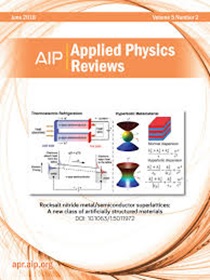Materials discovery in combinatorial and high-throughput synthesis and processing: A new Frontier for SPM
IF 11.6
1区 物理与天体物理
Q1 PHYSICS, APPLIED
引用次数: 0
Abstract
For over three decades, scanning probe microscopy (SPM) has been a key method for exploring material structures and functionalities at nanometer and often atomic scales in ambient, liquid, and vacuum environments. Historically, SPM applications have predominantly been downstream, with images and spectra serving as a qualitative source of data on the microstructure and properties of materials, and in rare cases of fundamental physical knowledge. However, the fast-growing developments in accelerated material synthesis via self-driving labs and established applications such as combinatorial spread libraries are poised to change this paradigm. Rapid synthesis demands matching capabilities to probe the structure and functionalities of materials on small scales and with high throughput. SPM inherently meets these criteria, offering a rich and diverse array of data from a single measurement. Here, we overview SPM methods applicable to these emerging applications and emphasize their quantitativeness, focusing on piezoresponse force microscopy, electrochemical strain microscopy, conductive, and surface photovoltage measurements. We discuss the challenges and opportunities ahead, asserting that SPM will play a crucial role in closing the loop from material prediction and synthesis to characterization.组合和高通量合成和加工中的材料发现:SPM的新前沿
三十多年来,扫描探针显微镜(SPM)一直是在纳米和原子尺度上探索环境、液体和真空环境中材料结构和功能的关键方法。从历史上看,SPM的应用主要是在下游,图像和光谱作为材料微观结构和性能的定性数据源,在极少数情况下是基础物理知识。然而,通过自动驾驶实验室和已建立的应用程序(如组合扩散库)加速材料合成的快速发展正准备改变这种范式。快速合成需要在小尺度和高通量下探测材料的结构和功能的匹配能力。SPM本质上符合这些标准,从一次测量中提供丰富多样的数据。在这里,我们概述了适用于这些新兴应用的SPM方法,并强调了它们的定量,重点是压响应力显微镜,电化学应变显微镜,导电和表面光电压测量。我们讨论了未来的挑战和机遇,并断言SPM将在材料预测和合成到表征的闭环中发挥至关重要的作用。
本文章由计算机程序翻译,如有差异,请以英文原文为准。
求助全文
约1分钟内获得全文
求助全文
来源期刊

Applied physics reviews
PHYSICS, APPLIED-
CiteScore
22.50
自引率
2.00%
发文量
113
审稿时长
2 months
期刊介绍:
Applied Physics Reviews (APR) is a journal featuring articles on critical topics in experimental or theoretical research in applied physics and applications of physics to other scientific and engineering branches. The publication includes two main types of articles:
Original Research: These articles report on high-quality, novel research studies that are of significant interest to the applied physics community.
Reviews: Review articles in APR can either be authoritative and comprehensive assessments of established areas of applied physics or short, timely reviews of recent advances in established fields or emerging areas of applied physics.
 求助内容:
求助内容: 应助结果提醒方式:
应助结果提醒方式:


